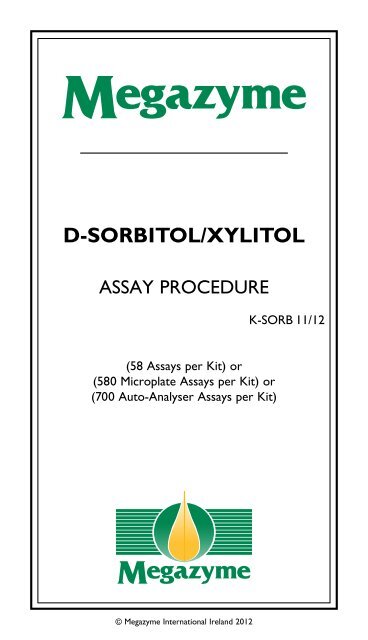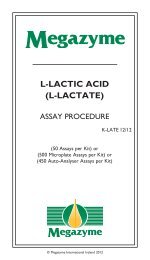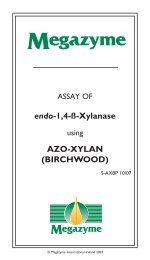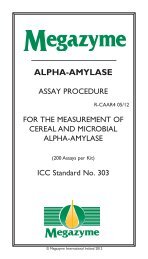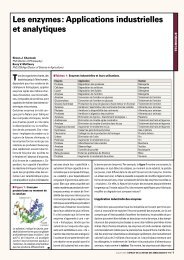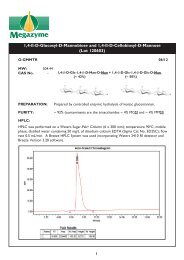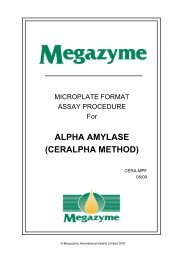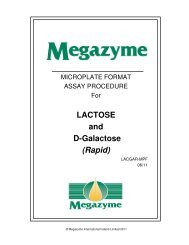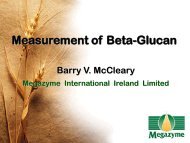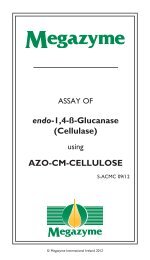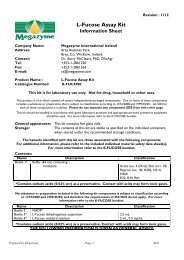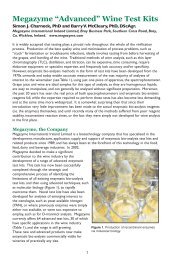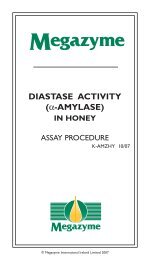D-SORBITOL/XYLITOL - Megazyme
D-SORBITOL/XYLITOL - Megazyme
D-SORBITOL/XYLITOL - Megazyme
You also want an ePaper? Increase the reach of your titles
YUMPU automatically turns print PDFs into web optimized ePapers that Google loves.
D-<strong>SORBITOL</strong>/<strong>XYLITOL</strong><br />
ASSAY PROCEDURE<br />
K-SORB 11/12<br />
(58 Assays per Kit) or<br />
(580 Microplate Assays per Kit) or<br />
(700 Auto-Analyser Assays per Kit)<br />
© <strong>Megazyme</strong> International Ireland 2012
INTRODUCTION:<br />
Sorbitol, a polyol (sugar alcohol), is a bulk sweetener found in<br />
numerous food products. Sorbitol is approximately 60% as sweet<br />
as sucrose with one-third of the calories. It has a smooth mouth<br />
feel with a sweet, cool and pleasant taste. Sorbitol is non-cariogenic<br />
and finds many dietetic applications, but can cause gastrointestinal<br />
problems in adults if large quantities are consumed (10-50 g per day).<br />
It has been safely used in processed foods for almost half a century<br />
and finds applications in the cosmetics and pharmaceuticals industries.<br />
Sorbitol occurs naturally in a wide variety of fruits and berries. It is<br />
produced commercially by the hydrogenation of glucose. It has been<br />
affirmed GRAS (generally recognised as safe) by the U.S. Food and<br />
Drug Administration and has been approved for food use in Europe<br />
and many other countries around the world.<br />
PRINCIPLE:<br />
D-Sorbitol is oxidised by nicotinamide-adenine dinucleotide (NAD + )<br />
to D-fructose in the presence of sorbitol dehydrogenase (SDH)<br />
with the formation of reduced nicotinamide-adenine dinucleotide<br />
(NADH) (1). In a parallel reaction, the enzyme also oxidises xylitol<br />
to D-xylulose (2).<br />
(SDH)<br />
(1) D-Sorbitol + NAD + D-fructose + NADH + H +<br />
(SDH)<br />
(2) Xylitol + NAD + D-xylulose + NADH + H +<br />
However, since the equilibrium of reactions (1) and (2) lie in favour<br />
of D-sorbitol and xylitol, respectively, and NAD + , a further reaction<br />
is required to utilise the NADH product. In this second reaction,<br />
in the presence of diaphorase, NADH reduces iodonitrotetrazolium<br />
chloride (INT) to an INT-formazan compound (3).<br />
(diaphorase)<br />
(3) NADH + INT + H + NAD + + INT-formazan<br />
The amount of INT-formazan formed in this reaction is<br />
stoichiometric with the amount of D-sorbitol or xylitol. It is the<br />
INT-formazan which is measured by the increase in absorbance at<br />
492 nm.<br />
1
SPECIFICITY, SENSITIVITY, LINEARITY AND PRECISION:<br />
As well as D-sorbitol and xylitol, sorbitol dehydrogenase also oxidises<br />
other polyols such as tibitol, iditol and allitol, but with a lower rate.<br />
Polyalcohols such as D-mannitol, L-arabitol and dulcitol do not react.<br />
Under the assay conditions described on page 5, glycerol is oxidised<br />
very slowly (approx. 0.4% conversion with 100 μg of glycerol/assay),<br />
as is galactitol (approx. 3% conversion with 10 μg of galactitol/assay).<br />
However, the contribution of these substances, if present in the sample,<br />
can be taken into account by extrapolation back to the time of addition<br />
of the sorbitol dehydrogenase, using the linear “creep rate” of the<br />
reaction.<br />
The smallest differentiating absorbance for the assay is 0.005<br />
absorbance units. This corresponds to 0.066/0.055 mg of D-sorbitol<br />
or xylitol/L of sample solution at the maximum sample volume of<br />
2.00 mL. The detection limit is 0.197/0.165 mg/L, which is derived<br />
from an absorbance difference of 0.015 with the maximum sample<br />
volume of 2.00 mL.<br />
The assay is linear over the range of 1.0 to 20 μg of D-sorbitol (or<br />
xylitol) per assay. In duplicate determinations using one sample<br />
solution, an absorbance difference of 0.005 to 0.010 may occur. With<br />
a sample volume of 2.00 mL, this corresponds to a D-sorbitol/xylitol<br />
concentration of approx. 0.066/0.055 to 0.13/0.11 mg/L of sample<br />
solution. If the sample is diluted during sample preparation, the result<br />
is multiplied by the dilution factor, F. If in sample preparation, the<br />
sample is weighed, e.g. 10 g/L, a difference of 0.02 to 0.05 g/100 g can<br />
be expected.<br />
Coefficients of variation values between 1.0-3.3% (w/v or w/w) appear<br />
in the literature for measurement of D-sorbitol in solution or in baked<br />
goods. 1,2<br />
INTERFERENCE:<br />
High concentrations of reducing substances, such as L-ascorbic acid in<br />
fruit juices, or SO 2 in jam, interfere with the assay as they react with<br />
INT causing a “creep” reaction. Concentrations of L-ascorbic acid<br />
higher than 5 μg/mL should be removed by treating the sample with<br />
H 2 O 2 /alkali and catalase [see Sample Preparation Example (a)].<br />
Reducing sugars (e.g. D-glucose) up to 1 mg per assay do not interfere<br />
with the assay (over a period of 60 min).<br />
If the conversion of D-sorbitol or xylitol has been completed within<br />
the time specified in the assay, it can be generally concluded that no<br />
interference has occurred. However, this can be further checked by<br />
2
adding D-sorbitol or xylitol (approx. 10 μg in 0.1 mL) to the cuvette on<br />
completion of the reaction. A significant increase in the absorbance<br />
should be observed.<br />
Interfering substances in the sample being analysed can be identified<br />
by including an internal standard. Quantitative recovery of this<br />
standard would be expected. Losses in sample handling and extraction<br />
are identified by performing recovery experiments, i.e. by adding<br />
D-sorbitol or xylitol to the sample in the initial extraction steps.<br />
SAFETY:<br />
The reagents used in the determination of D-sorbitol/xylitol are<br />
not hazardous materials in the sense of the Hazardous Substances<br />
Regulations. However, the buffer concentrate contains methanol<br />
(12% v/v). The general safety measures that apply to all chemical<br />
substances should be adhered to.<br />
KITS:<br />
Kits suitable for performing 58 assays in manual format (or 700<br />
assays in auto-analyser format or 580 assays in microplate format) are<br />
available from <strong>Megazyme</strong>. The kits contain the full assay method plus:<br />
Bottle 1: Buffer (40 mL, pH 8.6).<br />
Stable for > 2 years at 4°C.<br />
NOTE: Methanol is a poisonous chemical, so the buffer should be<br />
handled with gloves. Methanol positively contributes to the assay by<br />
lowering the assay blank value (“creep” value). Buffer not containing<br />
methanol is available on request.<br />
Bottle 2: (x2) NAD + plus INT.<br />
Stable for > 2 years at -20°C.<br />
Bottle 3:<br />
Diaphorase suspension (1.25 mL).<br />
Stable for > 2 years at 4°C.<br />
Bottle 4: (x3) Sorbitol dehydrogenase lyophilisate.<br />
Stable for > 2 years at -20°C.<br />
Bottle 5:<br />
D-Sorbitol standard solution (5 mL, 0.10 mg/mL) in<br />
0.02% (w/v) sodium azide.<br />
Stable for > 2 years at 4°C.<br />
3
PREPARATION OF REAGENT SOLUTIONS/SUSPENSIONS:<br />
1. Use the contents of bottle 1 as supplied.<br />
Stable for > 2 years at 4°C.<br />
2. Dissolve contents of one of bottle 2 in 6.0 mL of distilled water.<br />
Divide into appropriately sized aliquots and store in a dark<br />
container at -20°C between use and keep cool during<br />
use if possible. Stable for > 12 months at -20°C.<br />
3. Use the contents of bottle 3 as supplied. Before opening for<br />
the first time, shake the bottle to remove any enzyme that<br />
may have settled on the rubber stopper. Subsequently, store<br />
the bottle in an upright position. Swirl the bottle to mix<br />
contents before use. Stable for > 2 years 4°C.<br />
4. Dissolve the contents of one of bottle 4 in 1.0 mL of distilled<br />
water. Store at 4°C between use and on ice during use.<br />
On dissolution, this enzyme is unstable to freezing,<br />
but is stable for approx. 2 months at 4°C.<br />
5. Use the contents of bottle 5 as supplied.<br />
Stable for > 2 years at 4°C.<br />
NOTE: The D-sorbitol standard solution is only assayed where there<br />
is some doubt about the accuracy of the spectrophotometer being<br />
used or where it is suspected that inhibition is being caused by<br />
substances in the sample. The concentration of D-sorbitol/xylitol is<br />
determined directly from the extinction coefficient of INT-formazan<br />
(page 6).<br />
EQUIPMENT (RECOMMENDED):<br />
1. Glass test tubes (round bottomed; 16 x 100 mm).<br />
2. Disposable plastic cuvettes (1 cm light path, 3.0 mL).<br />
3. Micro-pipettors, e.g. Gilson Pipetman ® (20 μL, 100 μL and 200 μL).<br />
4. Positive displacement pipettor, e.g. Eppendorf Multipette ®<br />
- with 5.0 mL Combitip ® (to dispense 0.5 mL aliquots of<br />
buffer 1 and 0.2 mL aliquots of NAD + /INT solution).<br />
- with 25.0 mL Combitip ® (to dispense 2.0 mL aliquots of<br />
distilled water).<br />
5. Analytical balance.<br />
6. Spectrophotometer set at 492 nm.<br />
7. Vortex mixer (e.g. IKA ® Yellowline Test Tube Shaker TTS2).<br />
8. Stop clock.<br />
9. Whatman No.1 (9 cm) filter papers.<br />
4
MANUAL ASSAY PROCEDURE:<br />
Wavelength: 492 nm<br />
Cuvette:<br />
1 cm light path (glass or plastic)<br />
Temperature: ~ 25°C<br />
Final volume: 2.87 mL<br />
Sample solution: 1.0-20 μg of D-sorbitol plus xylitol per<br />
cuvette (in 0.10-2.0 mL sample volume)<br />
Read against air (without a cuvette in the light path) or against water<br />
Pipette into cuvettes Blank Sample<br />
distilled water (at ~ 25°C) 2.10 mL 2.00 mL<br />
sample - 0.10 mL<br />
solution 1 (buffer) 0.50 mL 0.50 mL<br />
solution 2 (NAD + /INT) 0.20 mL 0.20 mL<br />
suspension 3 (Diaphorase) 0.02 mL 0.02 mL<br />
Mix*, read the absorbances of the solutions (A 1 ) after approx. 2 min.<br />
Repeat the measurement after another 2 min. If a change in<br />
absorbance greater than 0.010 is observed, the sample must be<br />
treated to remove reducing substances (see “interference” section<br />
on page 2). Start the reactions immediately by addition of:<br />
solution 4 (SDH) 0.05 mL 0.05 mL<br />
Mix*, read the absorbances of the solutions (A 2 ) at the end of the<br />
reaction (approx. 15 min). If the reaction has not stopped after<br />
20 min, continue to read the absorbances at 5 min intervals until the<br />
absorbances increase constantly over 5 min** (see Figures 1 and 2).<br />
* for example with a plastic spatula or by gentle inversion after sealing<br />
the cuvette with a cuvette cap or Parafilm ® .<br />
** if this “creep” rate is greater for the sample than for the blank,<br />
extrapolate the absorbances (sample and blank) back to the time of the<br />
addition of solution 4 (SDH).<br />
NOTE: INT and the reaction system containing INT are sensitive<br />
to light. Consequently, reactions must be performed in the dark<br />
(e.g. in the spectrophotometer cuvette compartment with the<br />
photometer lid closed).<br />
5
CALCULATION:<br />
Determine the absorbance difference (A 2 -A 1 ) for both blank and<br />
sample. Subtract the absorbance difference of the blank from the<br />
absorbance difference of the sample, thereby obtaining<br />
ΔA D-sorbitol/xylitol .<br />
The value of ΔA D-sorbitol/xylitol should as a rule be at least 0.100<br />
absorbance units to achieve sufficiently accurate results.<br />
The concentration of D-sorbitol/xylitol can be calculated as follows:<br />
c = V x MW x ΔA [g/L]<br />
ε x d x v<br />
where:<br />
V<br />
MW<br />
ε<br />
d<br />
v<br />
= final volume [mL]<br />
= molecular weight of the substance being assayed [g/mol]<br />
= extinction coefficient of INT-formazan at 492 nm<br />
= 19900 [l x mol -1 x cm -1 ]<br />
= light path [cm]<br />
= sample volume [mL]<br />
It follows for D-sorbitol:<br />
c = 2.87 x 182.17 x ΔA D-sorbitol [g/L]<br />
19900 x 1.0 x 0.10<br />
= 0.2627 x ΔA D-sorbitol [g/L]<br />
for xylitol:<br />
c = 2.87 x 152.15 x ΔA xylitol [g/L]<br />
19900 x 1.0 x 0.10<br />
= 0.2194 x ΔA xylitol [g/L]<br />
This calculation is correct only if just D-sorbitol or xylitol is present<br />
in the sample solution.<br />
If the sample has been diluted during preparation, the result must be<br />
multiplied by the dilution factor, F.<br />
When analysing solid and semi-solid samples which are weighed out<br />
for sample preparation, the content (g/100 g) is calculated from the<br />
amount weighed as follows:<br />
6
Content of D-sorbitol<br />
= c D-sorbitol [g/L sample solution] x 100 [g/100 g]<br />
weight sample [g/L sample solution]<br />
Content of xylitol<br />
= c xylitol [g/L sample solution] x 100 [g/100 g]<br />
weight sample [g/L sample solution]<br />
NOTE: These calculations can be simplified by using the <strong>Megazyme</strong><br />
Mega-Calc TM , downloadable from where the product appears in<br />
the <strong>Megazyme</strong> web site (www.megazyme.com).<br />
7
AUTO-ANALYSER ASSAY PROCEDURE:<br />
NOTES:<br />
1. The Auto-Analyser Assay Procedure for D-sorbitol / xylitol<br />
can be performed using either a single point standard or a full<br />
calibration curve.<br />
2. For each batch of samples that is applied to the determination<br />
of D-sorbitol / xylitol either a single point standard or a<br />
calibration curve must be performed concurrently using<br />
the same batch of reagents.<br />
Reagent preparation is performed as follows:<br />
Preparation of R1:<br />
Component<br />
distilled water<br />
solution 1 (buffer)<br />
solution 2 (NAD + /INT)<br />
suspension 3 (Diaphorase)<br />
Total volume<br />
Volume<br />
34.5 mL<br />
10 mL<br />
4.0 mL (after adding 6 mL of H 2 O to bottle 2)<br />
0.4 mL<br />
48.9 mL<br />
Preparation of R2:<br />
Component<br />
Volume<br />
solution 4 (SDH) 6.1 mL (after adding 6.1 mL of H 2 O to bottle 4)<br />
Total volume<br />
6.1 mL<br />
EXAMPLE METHOD:<br />
R1: 0.200 mL<br />
Sample:<br />
~ 0.01 mL<br />
R2: 0.025 mL<br />
Reaction time: ~ 15 min at 37°C<br />
Wavelength:<br />
492 nm<br />
Prepared reagent stability: > 7 days when refrigerated<br />
Calculation:<br />
endpoint<br />
Reaction direction:<br />
increase<br />
Linearity:<br />
up to 163 mg/L of D-sorbitol<br />
/ xylitol using 0.01 mL sample<br />
volume<br />
8
MICROPLATE ASSAY PROCEDURE:<br />
NOTES:<br />
1. The Microplate Assay Procedure for D-sorbitol / xylitol can be<br />
performed using either a single point standard or a full calibration curve.<br />
2. For each batch of samples that is applied to the determination<br />
of D-sorbitol / xylitol either a single point standard or a<br />
calibration curve must be performed concurrently using<br />
the same batch of reagents.<br />
Wavelength: 492 nm<br />
Microplate: 96-well (e.g. clear flat-bottomed, glass or plastic)<br />
Temperature: ~ 25°C<br />
Final volume: 0.287 mL<br />
Linearity: 0.1-2 μg of D-sorbitol / xylitol per well<br />
(in 0.01-0.2 mL sample volume)<br />
Pipette into wells Blank Sample Standard<br />
distilled water<br />
sample solution<br />
standard solution<br />
solution 1 (buffer)<br />
solution 2 (NAD + /INT)<br />
suspension 3 (Diaphorase)<br />
0.210 mL<br />
-<br />
-<br />
0.050 mL<br />
0.020 mL<br />
0.002 mL<br />
0.200 mL<br />
0.010 mL<br />
-<br />
0.050 mL<br />
0.020 mL<br />
0.002 mL<br />
0.200 mL<br />
-<br />
0.010 mL<br />
0.050 mL<br />
0.020 mL<br />
0.002 mL<br />
Mix*, read the absorbances of the solutions (A 1 ) after approx. 2 min<br />
and start the reactions by addition of:<br />
solution 4 (SDH) 0.005 mL 0.005 mL 0.005 mL<br />
Mix*, read the absorbances of the solutions (A 2 ) at the end of the<br />
reaction (approx. 15 min). If the reaction has not stopped after 15<br />
min, continue to read the absorbances at 5 min intervals until the<br />
absorbances increase constantly over 5 min**.<br />
* for example using microplate shaker, shake function on a microplate<br />
reader, or repeated aspiration (e.g. using a pipettor set at 50 - 100 μL<br />
volume).<br />
** if this “creep” rate is greater for the sample than for the blank, extrapolate<br />
the sample absorbances back to the time of addition of solution 4.<br />
CALCULATION (Microplate Assay Procedure):<br />
g/L = ∆Asample x g/L standard x F<br />
∆Astandard<br />
If the sample is diluted during preparation, the result must be<br />
multiplied by the dilution factor, F.<br />
9
SAMPLE PREPARATION:<br />
1. Sample dilution.<br />
The amount of D-sorbitol or xylitol present in the cuvette (i.e. in the<br />
0.1 mL of sample being analysed) should range between 1.0 and 20 μg.<br />
The sample solution must therefore be diluted sufficiently to yield a<br />
D-sorbitol or xylitol concentration between 0.010 and 0.20 g/L.<br />
Dilution Table<br />
Estimated concentration of Dilution Dilution<br />
D-sorbitol or xylitol (g/L) with water factor (F)<br />
< 0.20 No dilution required 1<br />
0.2-2.0 1 + 9 10<br />
2.0-20 1 + 99 100<br />
> 20 1 + 999 1000<br />
If the value of ΔA D-sorbitol/xylitol is too low (e.g. < 0.100), weigh out<br />
more sample or dilute less strongly. Alternatively, the sample volume<br />
to be pipetted into the cuvette can be increased up to 2.00 mL, making<br />
sure that the sum of the sample and distilled water components in the<br />
reaction is 2.10 mL and using the new sample volume in the equation.<br />
2. Sample clarification:<br />
(a) Solutions:<br />
Carrez I solution. Dissolve 3.60 g of potassium hexacyanoferrate<br />
(II) {K 4 [Fe(CN) 6 ].3H 2 O} (Sigma cat. no. P-9387) in 100 mL of distilled<br />
water. Store at room temperature.<br />
Carrez II solution. Dissolve 7.20 g of zinc sulphate (ZnSO 4 .7H 2 O)<br />
(Sigma cat. no. Z-4750) in 100 mL of distilled water. Store at room<br />
temperature.<br />
Sodium hydroxide (NaOH, 100 mM). Dissolve 4 g of NaOH in<br />
1 L of distilled water. Store at room temperature.<br />
(b) Procedure:<br />
Pipette the liquid sample into a 100 mL volumetric flask which<br />
contains approx. 60 mL of distilled water, or weigh sufficient quantity<br />
of the sample into a 100 mL volumetric flask and add 60 mL of<br />
distilled water. Carefully add 5 mL of Carrez I solution, 5 mL of<br />
Carrez II solution and 10 mL of NaOH solution (100 mM). Mix after<br />
each addition. Fill the volumetric flask to the mark, mix and filter.<br />
10
3. General considerations.<br />
(a) Liquid samples: clear, slightly coloured and approximately<br />
neutral, liquid samples can be used directly in the assay.<br />
(b) Acidic samples: if > 0.1 mL of an acidic sample is to be used<br />
undiluted (such as wine or fruit juice), the pH of the solution should<br />
be increased to approx. 8.6 using 2 M NaOH, and the solution<br />
incubated at room temperature for 30 min.<br />
(c) Carbon dioxide: samples containing a significant amount of<br />
carbon dioxide, such as beer, should be degassed by increasing the<br />
pH to approx. 8.6 with 2 M NaOH and gentle stirring, or by stirring<br />
with a glas rod.<br />
(d) Coloured samples: a sample blank, i.e. sample with no<br />
SDH, may be necessary in the case of coloured samples.<br />
(e) Strongly coloured samples: if used undiluted, strongly<br />
coloured samples should be treated by the addition of 0.2 g of<br />
polyvinylpolypyrrolidone (PVPP)/10 mL of sample. Shake the tube<br />
vigorously for 5 min and then filter through Whatman No. 1 filter<br />
paper.<br />
(f) Solid samples: homogenise or crush solid samples in distilled<br />
water and filter if necessary.<br />
(g) Samples containing fat: extract such samples with hot water<br />
at a temperature above the melting point of the fat, e.g. in a 100 mL<br />
volumetric flask. Adjust to room temperature and fill the volumetric<br />
flask to the mark with water. Store on ice or in a refrigerator for<br />
15-30 min and then filter. Discard the first few mL of filtrate, and<br />
use the clear supernatant (which may be slightly opalescent) for assay.<br />
Alternatively, clarify with Carrez reagents.<br />
(h) Samples containing protein: deproteinise samples containing<br />
protein by adding an equal volume of ice-cold 1 M perchloric acid<br />
with mixing. Centrifuge at 1,500 g for 10 min and neutralise the<br />
supernatant with 1 M KOH. Alternatively use Carrez reagents.<br />
11
SAMPLE PREPARATION EXAMPLES:<br />
(a) Determination of D-sorbitol/xylitol in fruit juice.<br />
Pipette 5.0 mL of blackcurrent juice or 1.0 mL of apple juice (filtered<br />
if necessary) into a 50 mL volumetric flask. Add successively 30 mL<br />
of distilled water, 1 mL KOH (2 M) and 0.05 mL of H 2 O 2 solution<br />
(30% v/v), mix and incubate for 15 min at 25°C. Adjust the pH to<br />
approx. 8.0 by the addition of H 2 SO 4 (1 M). Add 0.01 mL of<br />
catalase, mix and incubate for 20 min at approx. 25°C, fill the<br />
volumetric flask to the mark with water and filter. Use the filtrate<br />
for the assay. As can be seen from Figure 2, with blackcurrent juice<br />
preparation there is an immediate linear increase in absorbance,<br />
but this is not due to D-sorbitol. When D-sorbitol was added at<br />
1-10 μg/assay, the absorbance increased rapidly and then continued<br />
increasing at the same rate as the background reaction (blackcurrent<br />
juice + no added D-sorbitol). These results indicate that this<br />
particular blackcurrent juice contains little, if any, D-sorbitol.<br />
(b) Determination of D-sorbitol/xylitol in diabetic honey.<br />
Accurately weigh approx. 5 g of honey into a 100 mL volumetric<br />
flask, add approx. 70 mL of distilled water and incubate for 10 min at<br />
approx. 60°C. Allow to cool and fill to the mark with distilled water.<br />
Dilute the solution according to the dilution table and assay.<br />
(c) Determination of D-sorbitol/xylitol in samples containing<br />
protein.<br />
Deproteinise samples containing protein by adding an equal volume of<br />
ice-cold 1 M perchloric acid with mixing. Centrifuge at 1,500 g for<br />
10 min and neutralise the supernatant with 1 M KOH. Alternatively<br />
use Carrez reagents.<br />
(d) Determination of D-sorbitol in chewing gum.<br />
Accurately weigh approx. 2 g of representative chewing gum sample<br />
into a 50 mL Duran ® bottle. Add 10 mL of toluene and 20 mL of<br />
distilled water and stir the slurry on a magnetic stirrer for about<br />
20 min (until the gum is fully dispersed). Centrifuge the suspension at<br />
1,500 g in sealed polypropylene tubes, and carefully remove the upper<br />
phase (toluene) and discard with waste solvents. Transfer the lower<br />
phase (aqueous) to a 100 mL volumetric flask and adjust to volume.<br />
Use 0.1 mL for assay.<br />
(e) Further applications.<br />
For details of sampling, treatment and stability of other samples, such<br />
as pharmaceuticals, cosmetics, etc., refer to Bergmeyer (1988). 1<br />
12
20 μg<br />
Absorbance, 492 nm<br />
15 μg<br />
10 μg<br />
5 μg<br />
2.5 μg<br />
Incubation time, min<br />
0 μg<br />
Figure 1. Increase in absorbance at 492 nm on incubation of<br />
D-sorbitol with SDH under standard assay conditions. Levels of<br />
added D-sorbitol were: 0, 2.5, 5, 10, 15 and 20 μg.<br />
Absorbance, 492 min<br />
Reaction<br />
blank<br />
Incubation time, min<br />
Figure 2. Increase in absorbance at 492 nm on incubation of<br />
blackcurrent preparation [see sample preparation example (a)] with<br />
and without added D-sorbitol with SDH. Levels of added D-sorbitol<br />
were: 0, 1, 2, 4, 8 and 10 μg.<br />
13
NOTES:<br />
14
REFERENCES:<br />
1. Bergmeyer, H. U. (1988). D-Sorbitol. In Methods of Enzymatic<br />
Analysis (Bergmeyer, H. U. ed.), 3rd ed., Vol. VI, pp. 356-362,<br />
VCH Publishers (UK) Ltd., Cambridge, UK.<br />
2. Beutler, H. -O. (1988). Xylitol. In Methods of Enzymatic Analysis<br />
(Bergmeyer, H. U. ed.), 3rd ed., Vol. VI, pp. 484-490, VCH<br />
Publishers (UK) Ltd., Cambridge, UK.<br />
3. International Federation of Fruit Juice Producers (IFU, Methods<br />
of Analysis, no. 62-1995); contained in “Code of Practice for<br />
Evaluation of Fruit and Vegetable Juices” (1996) edited by<br />
Association of the Industry of Juices and Nectars from Fruits<br />
and Vegetables of the European Economic Community (A.I.J.N.).<br />
<strong>Megazyme</strong> International Ireland,<br />
Bray Business Park, Bray,<br />
Co. Wicklow,<br />
IRELAND.<br />
Telephone: (353.1) 286 1220<br />
Facsimile: (353.1) 286 1264<br />
Internet: www.megazyme.com<br />
E-Mail: info@megazyme.com<br />
WITHOUT GUARANTEE<br />
The information contained in this booklet is, to the best of our knowledge, true and accurate, but<br />
since the conditions of use are beyond our control, no warranty is given or is implied in respect of<br />
any recommendation or suggestions which may be made or that any use will not infringe any patents.<br />
15


